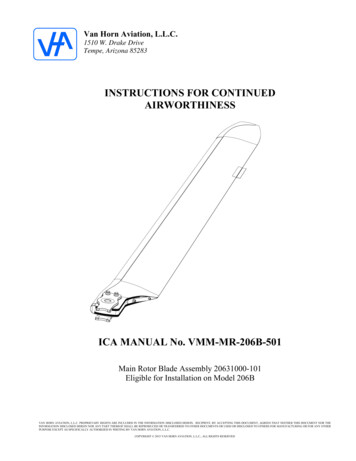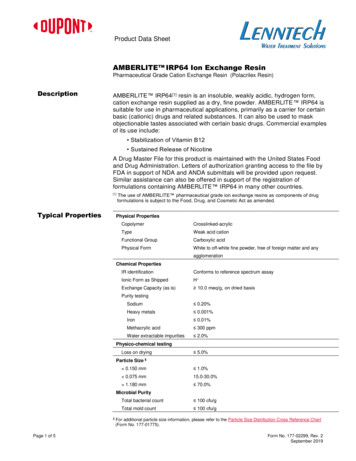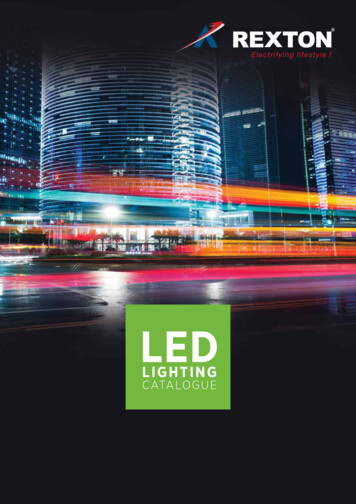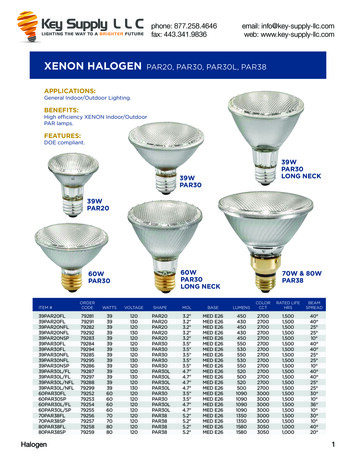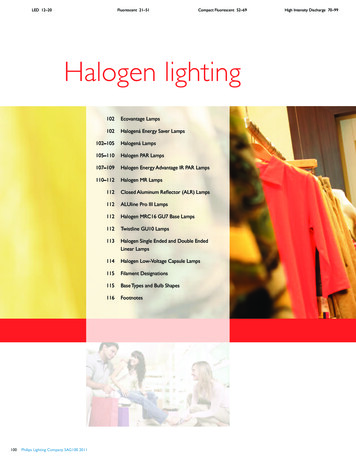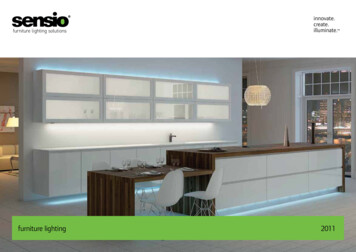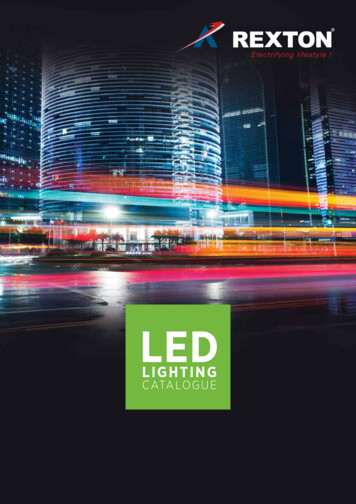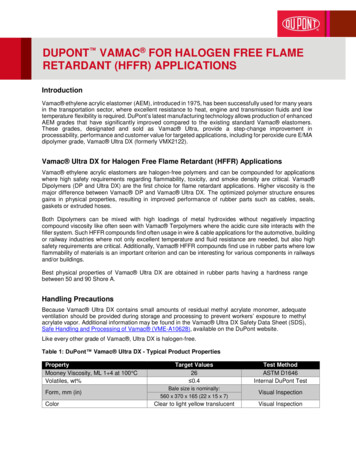
Transcription
DUPONT VAMAC FOR HALOGEN FREE FLAMERETARDANT (HFFR) APPLICATIONSIntroductionVamac ethylene acrylic elastomer (AEM), introduced in 1975, has been successfully used for many yearsin the transportation sector, where excellent resistance to heat, engine and transmission fluids and lowtemperature flexibility is required. DuPont’s latest manufacturing technology allows production of enhancedAEM grades that have significantly improved compared to the existing standard Vamac elastomers.These grades, designated and sold as Vamac Ultra, provide a step-change improvement inprocessability, performance and customer value for targeted applications, including for peroxide cure E/MAdipolymer grade, Vamac Ultra DX (formerly VMX2122).Vamac Ultra DX for Halogen Free Flame Retardant (HFFR) ApplicationsVamac ethylene acrylic elastomers are halogen-free polymers and can be compounded for applicationswhere high safety requirements regarding flammability, toxicity, and smoke density are critical. Vamac Dipolymers (DP and Ultra DX) are the first choice for flame retardant applications. Higher viscosity is themajor difference between Vamac DP and Vamac Ultra DX. The optimized polymer structure ensuresgains in physical properties, resulting in improved performance of rubber parts such as cables, seals,gaskets or extruded hoses.Both Dipolymers can be mixed with high loadings of metal hydroxides without negatively impactingcompound viscosity like often seen with Vamac Terpolymers where the acidic cure site interacts with thefiller system. Such HFFR compounds find often usage in wire & cable applications for the automotive, buildingor railway industries where not only excellent temperature and fluid resistance are needed, but also highsafety requirements are critical. Additionally, Vamac HFFR compounds find use in rubber parts where lowflammability of materials is an important criterion and can be interesting for various components in railwaysand/or buildings.Best physical properties of Vamac Ultra DX are obtained in rubber parts having a hardness rangebetween 50 and 90 Shore A.Handling PrecautionsBecause Vamac Ultra DX contains small amounts of residual methyl acrylate monomer, adequateventilation should be provided during storage and processing to prevent workers’ exposure to methylacrylate vapor. Additional information may be found in the Vamac Ultra DX Safety Data Sheet (SDS),Safe Handling and Processing of Vamac (VME-A10628), available on the DuPont website.Like every other grade of Vamac , Ultra DX is halogen-free.Table 1: DuPont Vamac Ultra DX - Typical Product PropertiesPropertyMooney Viscosity, ML 1 4 at 100 CVolatiles, wt%Form, mm (in)ColorTarget Values26 0.4Test MethodASTM D1646Internal DuPont TestBale size is nominally:560 x 370 x 165 (22 x 15 x 7)Visual InspectionClear to light yellow translucentVisual Inspection
MixingVamac Ultra DX has higher viscosity than Vamac DP which allows better and faster dispersion of fillersand other compounding ingredients. Due to the general good scorch safety of peroxide cured compounds,changes in mixing cycle due to higher viscosity are not considered necessary.Mixing of HFFR compounds: physical properties of the compounds will vary depending on the mixingprocedure and the mixing time. Compounds mixed using only an open roll mill with long mixing cycles willhave improved physical properties compared to compounds mixed in an internal mixer and a short timeon the open mill.HFFR Compounding and Physical Propertiesa) General Starting Point FormulationsTypical non-halogenated flame retardant fillers like aluminum or magnesium hydroxide (ATH, Mg(OH) 2)can be used with Vamac Dipolymers to achieve flame resistance, low smoke density and low toxicityperformance as required by the railway industry. A typical HFFR compound formulation, which can beused as a starting point for halogen-free, flame retardant compounds, based on Vamac Dipolymer, isshown in Table 2.Table 2: HFFR Starting Point Formulation with Vamac DipolymersFormulationVamac DP/Ultra DXArmeen 18DStearic AcidNaugard 445Martinal OL 111 LESilanogran HVSOfalub SEOLuperox 101 XL 45Vulcofac 13 PDMphr1000,5111502152DescriptionPolymerProcess aidProcess aidAntioxidantATHSilane coupling agentProcess aidPeroxideCo-agentTable 3 shows a comparison of Vamac Ultra DX to Vamac DP in an identical formulation. Higher Mooneyviscosity is the major difference between Vamac Ultra DX and Vamac DP. The tighter crosslinknetwork and faster cure leads to slightly higher Hardness, with higher Tensile Strength, and still slightlyhigher Elongation at Break. Tear strength is improved with Vamac Ultra DX while the Tg is comparable.Table 3: Comparison of Physical Properties of Vamac DP and Ultra DXCompound No.Vamac DPVamac Ultra DX (formerly VMX2122)Naugard 445Armeen 18 DStearic AcidMartinal OL-111 LEDynasylan 6490Perkadox 14-40B-GRRubber chem HVA-21*10010.51.516014.512*10010.51.516014.51
Mooney Viscosity ML 1 4, 100 C [MU] - PolymerMooney Viscosity ML 1 4, 100 C [MU] - CompoundMDR, 0.5 arc, 12 minutes at 180 CML [dNm]MH [dNm]T50 [min]T90 2616.6395.57911.52677.0386.5-29-28Press-Cure 15 minutes at 180 CHardness Shore ATensile Strength [MPa]Elongation at break [%]Modulus at 100% [MPa]Tear Die C at 23 C [N/mm]Trouser Tear Die A at 23 C [N/mm]Tg by DSC [ C]*mixed by open roll millAfter heat ageing, Vamac Ultra DX maintains its properties better than Vamac DP while the performanceafter fluid aging (IRM 903) is comparable. Table 4 summarizes the results.Table 4: Heat and Fluid Aging of Vamac DP and Ultra DXCompound No.Heat ageing 168hrs at 160 CHardness Shore ADelta Hardness [pts.]Tensile Strength [MPa]Delta TS [%]Elongation at break [%]Delta Elong. [%]Modulus at 100 % [MPa]Delta 100% [%]1282711.416209-208.32682412.37241-108.623Heat ageing 168hrs at 175 CHardness Shore ADelta Hardness [pts.]Tensile Strength [MPa]Delta TS [%]Elongation at break [%]Delta Elongation [%]Modulus at 100 % [MPa]Delta 100% [%]82610.810170-359.23983511.72184-319.434Fluid ageing 168hrs at 150 C in IRM 903
Hardness Shore ADelta Hardness [pts.]Tensile Strength [MPa]Delta TS [%]Elongation at break [%]Delta Elong. [%]Modulus at 100 % [MPa]Delta 100% [%]Volume change [%]Weight change 6b) Effect of Filler Amount, Particle Size, and Surface TreatmentVamac Dipolymer can be filled with high amounts of flame retardant filler, such as ATH. Table 5 shows thephysical properties of Ultra DX compounds using different amounts of ATH filler. Higher ATH loadings leadto increased Tensile Strengths and Modulus, while Elongation at Break is decreasing. Compression setremains comparable. The same recipes were used with Vamac DP. All compounds passed the UL 94 V-0test (2mm thick samples), similar results are expected by using Ultra DX.Table 5: Effect of ATH Filler Loading on Compound PropertiesCompound No.Vamac Ultra DX (formerly VMX2122)Silane treated ATH 7.5m2/g BET surface areaHindered Amine AODicumyl Peroxide, 40% activeTAIC310012515241001501525100175152Mooney Viscosity ML 1 4, 100 C ress-Cure 20 minutes at 170 CHardness Shore ATensile Strength [MPa]Elongation at break [%]Modulus at 100% [MPa]Compression set 70hrs at 150 C [%]Surface area of the used ATH grade will also affect compound properties. Higher surface area ATH willincrease the tensile strength while the LOI remains fairly constant. Special attention has to be paid to theuse and type of plasticizer which can interfere with the peroxide cure and can lead to decrease cure stateand mechanical properties, see table 6, compound 10. Best retention of properties after heat aging isachieved with higher surface area ATH, while the modulus change after fluid aging is highest with highsurface ATH.
Table 6: Effect of ATH Surface Area on Compound PropertiesCompound No.Vamac DPNaugard 445Armeen 18DStearic AcidMartinal OL-107 LEO (BET 7m 2/g)Martinal OL-111 LE (BET 11m2/g)Apyral 120E (BET 12 m2/g)Apyral 200SM (BET 20 m2/g)ADK Cizer RS 735Vinyl silanePerkadox 14-40B-GRRubber Chem 1Mooney Viscosity ML 1 4 @100 C26.530.736.139.516.5MDR 180 C/0.5deg/20minML (dNm)MH (dNm)t50 (min)t90 532150150Press-Cure 15 minutes at 180 CHardness Shore ATensile Strength [MPa]Elongation at break [%]Modulus at 50% [MPa]Modulus at 100% [MPa]LOI [%]* mixed by open roll millCompound No.Heat aging 168hrs at 160 CHardness Shore ADelta Hardness [pts]Tensile [MPa]Delta TS [%]Elongation [%]Delta Elongation [%]Modulus at 100 % [MPa]Delta 100 % .5-2156-1910.61286213.9-1175-1110.54Fluid aging IRM 903 168hrs at 100 CHardness Shore ADelta Hardness [pts]56-1958-2263-2161-22
Tensile [MPa]Delta TS [%]Elongation [%]Delta Elongation [%]Modulus at 100 % [MPa]Delta 100 % 6.3-3412.1-13170-136.6-34Surface treatment of ATH has a significant effect on the physical properties of the compound. Graph 1 showsthe difference of using untreated ATH versus surface treated ATH that can crosslink with the cure system.Instead of using surface treated ATH, a silane coupling agent can be used as well.Graph 1: Effect of ATH Surface Treatment
Vamac Dipolymer Blends with Thermoplastic PolymersFor Wire & Cable (W&C) applications Vamac Dipolymer HFFR compounds are often blended withthermoplastic polymers, partly to reduce cost but also to improve processing and physical properties.Suitable thermoplastic resins include e.g. Elvax or Hytrel .Vamac Dipolymer Blends with EVA ResinsVamac Dipolymers can be blended with Elvax 40L-03, an ethylene-vinyl acetate copolymer, to obtain aHFFR compound that shows improved processing and handling parameters important for W&C compounds.Elvax 40L-03 is a high molecular weight polymer containing 40wt% VA being fairly resistant to mechanicaldamage and elevated temperatures. The melting point is at 58 C and the maximum processing temperatureis at 230 C. It can be processed using conventional rubber processing techniques such as internal mixers,two-roll milling and compression molding.Addition of Elvax 40L-03 to Vamac Dipolymer in a typical HFFR starting point formulation increaseshardness, tensile strengths, and modulus, while elongation at break is reduced. Smoke toxicity is comparableand very low, while the smoke density is increased in the Elvax blend from Dsmax of 39 to 109 compared toa pure Vamac HFFR compound.Table 7: Vamac Ultra DX in Blends with Elvax 40L-03Compound No.Vamac Ultra DXVamac DPElvax 40L-03Struktol WS 280Armeen 18DStearic Acid Reagent (95%)Struktol WS 280Ofalub SEONaugard 445Martinal OL 111 LEMartinal OL 107 ZOLuperox 101 XL 45Silanogran HVSRubber chem HVA 2Vulcofac 13 222Mooney Viscosity ML 1 4 at 100 C5042383735MDR 15 minutes at 180 C, arc 0.5 ML [dNm]MH [dNm]T50 [min]T90 098110.6115Press-Cure 10 minutes at 180 CHardness Shore ATensile Strength [MPa]Elongation at break [%]
Modulus at 50 % [MPa]Modulus at 100 % [MPa]2.96.05.18.63.37.44.59.15.19.7Flammability BehaviorLOI [%]*Ds max (ISO 5659-2)CIT EN 45545-237200.1139640.08390.05-1090.05*according to ISO 4589 on 3mm thick test specimenVolume Swell in IRM 902 and IRM 903 increases with increasing amounts of Elvax blended into Vamac and reaches for IRM 902 between 10-20% and for IRM 903 between 20-60% depending on agingconditions and blends ratio, see Graph 2.Graph 2: IRM 902 and IRM 903 Swell if Vamac Ultra DX/Elvax 40L-03Volume Swell of Vamac DiPolymer and Elvax BlendsUltra DX/Elvax 70/30Ultra DXDP/Elvax 60/40DP/Elvax 80/20DP01020304050Volume Change [%]168h at 70 C in IRM 903168 hours at 100 C in IRM 90372h at 100 C in IRM 902168 hours at 70 C in IRM 9026070
Vamac Dipolymer Blends with Thermoplastic Elastomers (TPE)Hytrel Thermoplastic Polyester Elastomer has excellent low temperature flexibility and toughness, a broadtemperature range and good fluid resistance. In blends with Vamac Dipolymer it leads to compounds forthe W&C industry where excellent heat and oil resistance, low temperature flexibility and low fire hazardproperties are key requirements.Hytrel 4056 has a Shore D hardness of 40, with a melting point of 150 C and a Tg of -50 C and can beblended in various ratios with Vamac Dipolymer. Table 8 shows how Tg, viscosity and physical propertieschange with increasing amounts of Hytrel . A commonly used blend ratio in W&C applications is 70/30Vamac /Hytrel .Table 8: Vamac Ultra DX in Blends with Hytrel 4056Compound No.Vamac Ultra DXHytrel 4056Armeen 18DStearic Acid Reagent (95%)Ofalub SEONaugard 445Martinal OL 111 LELuperox 101 XL 45Silanogran HVSVulcofac 13 1505221950500.5111150522Blend Ratio Vamac Ultra DX / Hytrel 405610070/3060/4050/50Mooney Viscosity ML 1 4 at 80 C [MU]Mooney Viscosity ML 1 4 at 100 C DR 15 minutes at 180 C, arc 0.5 ML [dNm]MH [dNm]T50 [min]T90 [min]Press-Cure 10 minutes at 180 CHardness Shore ATensile Strength [MPa]Elongation at break [%]Modulus at 50 % [MPa]Modulus at 100 % [MPa]Low Temperature propertiesTg by DSC [ C]Tensile Properties at -30 CTensile Strength [MPa]Elongation at break [%]Modulus at 10 % [MPa]Modulus at 25 % [MPa]
Table 9 shows the typical properties of a 100% based Vamac Ultra DX compound versus aVamac /Hytrel blend (70/30). Compounds were mixed using the starting point formulation shown in Table2, for compound 20, 30 phr of Vamac Ultra DX were replaced with Hytrel 4056.Table 9: Vamac Ultra DX and in 70/30 Blend with Hytrel 4056 – Heat AgingCompound No.Vamac Ultra DXHytrel 4056Armeen 18DStearic Acid Reagent (95%)Ofalub SEONaugard 445Martinal OL 111 LELuperox 101 XL 45Silanogran HVSVulcofac 13 PDM111000.51111505222070300.5111150522Blend Ratio Vamac Ultra DX / Hytrel 405610070/30Hardness Shore A7492Tensile Strength [MPa]Elongation at break [%]Modulus at 50 % [MPa]Modulus at 100 % [MPa]8.72112.96.08.51756.68.3Heat ageing 168hrs at 135 CHardness Shore ADelta Hardness [pts.]Tensile Strength [MPa]Delta TS [%]Elongation at break [%]Delta Elongation [%]Modulus at 50 % [MPa]Delta 50% [%]Modulus at 100 % [MPa]Delta 100% 1Heat ageing 168hrs at 160 CHardness Shore ADelta Hardness [pts.]Tensile Strength [MPa]Delta TS [%]Elongation at break [%]841012.13917592010.624152Press-Cure 10 minutes at 180 C
Delta Elongation [%]Modulus at 50 % [MPa]Delta 50% [%]Modulus at 100 % [MPa]Delta 100% [%]Heat ageing 240hrs at 175 CHardness Shore ADelta Hardness [pts.]Tensile Strength [MPa]Elongation at break [%]Modulus at 50 % [MPa]Modulus at 100 % [MPa]-175.7969.965-138.22410.223cmpd no.16cmpd no.17871012.31166.911.09329.133-Heat aging performance of both compounds is very good at temperatures of 135 C and 160 C (168hrseach). At temperatures of 175 C (240hrs) the 100% Vamac Ultra DX compounds show significant betterretention of properties while after aging at 200 C (240hrs) both compounds have lost their elastomericbehavior. Fluid aging results in IRM 902 and IRM 903 are shown in Table 9.Graph 3: Heat Aging Performance Ultra DX and Hytrel Blend at Different Temperatures[%] ChangeTensile Strength and Elongation at Break Change after Heat Temperature [ C]TS Change Ultra DXTS Change Ultra DX/HytrelEB Change Ultra DXEB Change Ultra DX/Hytrel195
Table 9: Vamac Ultra DX and in 70/30 Blend with Hytrel 4056 – Fluid AgingCompound No.Blend Ratio Vamac Ultra DX / Hytrel 4056111002070/30Fluid ageing 72hrs at 100 C in IRM 902Hardness Shore ADelta Hardness [pts.]Tensile Strength [MPa]Delta TS [%]Elongation at break [%]Delta Elongation [%]Modulus at 50 % [MPa]Delta 50% [%]Modulus at 100 % [MPa]Delta 100% 211Weight Change [%]Volume change [%]61158Fluid ageing 168hrs at 70 C in IRM 903Hardness Shore ADelta Hardness [pts.]Tensile Strength [MPa]Delta TS [%]Elongation at break [%]Delta Elongation [%]Modulus at 50 % [MPa]Delta 50% [%]Modulus at 100 % [MPa]Delta 100% 18.2-1Weight Change [%]Volume change [%]1018814Table 10 summarizes some low temperature properties of the two compounds in comparison to a 100%EVM compound (same formulation as AEM compounds). Tg for the AEM compounds is more than 10 Clower than for the EVM compound and the Vamac /Hytrel blend passes also the low temperature bendtest.
Table 10: Vamac Ultra DX. 70/30 Hytrel Blend and EVM 700 – Low Temperature PropertiesCompound No.Vamac Ultra DXHytrel 4056EVM 700Armeen 18DStearic Acid Reagent (95%)Ofalub SEONaugard 445Martinal OL 111 LELuperox 101 XL 45Silanogran HVSVulcofac 13 50522crackno crackcrackTensile properties rtHardness Shore ATensile Strength [MPa]Elongation at break [%]Modulus at 50 % [MPa]Modulus at 100 % [MPa]748.72112.96.0928.51756.68.38410.61725.69.2Tg by DSC [ C]-28-29-16Tensile Properties at -30 CTensile Strength [MPa]Elongation at break [%]Modulus at 10 % [MPa]Modulus at 25 % ure 10 minutes at 180 CLow Temperature bend test -30 CGraph 4 shows a general low temperature comparison of AEM vs EVM. Vamac compounds will have aca. 10 C lower Tg at a comparable oil swell to EVM and a ca. 20-30% better oil resistance at the same Tgas EVM.
Graph 4: Comparison of the oils swell and Tg of AEM vs EVMFlammability, Smoke Density, and Toxicity DataVamac base polymers are all halogen free. The Limiting Oxygen Index (LOI) for the different Vamac grades is between 19-21%. Vamac Ultra DX base resin has a LOI of 21%. Through use of flame retardantfillers like ATH or Mg(OH)2 LOI values 30% can be reached depending on the exact compound composition.Table 11 summarizes some relevant flame properties of compound No. 11 and 20 (Vamac Ultra DX andVamac Ultra DX/Hytrel Blend) as well as an EVM (70% VA content) compound (No. 21) with identicalformulation.LOI measurements were conducted on 3mm thick test pieces. UL 94 measurements were done on 2mmthick test pieces.Smoke density and cone colorimeter testing was done with a 25 kW/m2 flame. Toxicity testing was doneaccording to NF X 70-100-1/2, calculation according to EN 45545-2. Sample thickness was 2mm.Table 11: Flammability, Smoke Density, and Toxicity DataNorm112021Ultra DXUltra DX/Hytrel70/30EVM 700Dsmax2021218VOF4779NF X 70-100-1/20.110.060.07ISO 4589-2373734Optical Density (25kW/m2 with flame)Gas Toxicity Analysis - CITLimited Oxygen Index (LOI) [%]ISO 5659-2
Cone Calorimeter (25kW/m2)ISO 5660-1Time To Ignition TTI [s]159120409Peak Heat Release Rate HRR [kW/m2]111121282Total Heat Release THR [MJ/m2]373835Total Smoke Release TSR [m2/s]311295791[kW/m2]616751UL 94 (2mm thick)V-0V-0V-0MARHEVamac Dipolymer Blends with Vamac Diamine Curable GradesVamac DP and Vamac Ultra DX are the only two Dipolymers in the Vamac portfolio without an acidiccure site monomer that can be used for diamine cure reactions. In HFFR formulation the Dipolymers aretypically the first choice of polymer grades because flame retardant metal oxides are not interacting with thepolymer chains, increasing viscosity of the compound and making processing difficult. Graph 5 shows acomparison of Mooney Viscosity of different Vamac base polymers and compounds. All compounds usestandard HFFR formulation (150 phr ATH, peroxide cured) and blends use 70/30 Vamac /Elvax ratio. Theviscosity increase from base resin to a mixed HFFR compound is significantly lower with the Dipolymer UltraDX compared to the Terpolymers. Overall polymer viscosity has an additional effect, as can be seen withVMX4017 (low temperature polymer) and Vamac G which are lower viscosity base polymers.Graph 5: Comparison Mooney Viscosity Increase Dipolymer versus TerpolymerTable 12 shows some blends of Vamac DP with Vamac G (60/40) and Vamac VMX4017 (70/30) thatstill provide compounds with reasonable viscosity ranges while showing some additional property benefitsthat can be achieved in HFFR formulations by blending different polymer types.
Table 12: Vamac Ultra DX blends with VMX4017 and Vamac GCompound No.Vamac Ultra DXVamac VMX 4017Vamac GMartinal OL 111 LEArmeen 18D PRILLSStearic Acid Reagent (95%)Ofalub SEONaugard 445Silanogran HVSSpheron SOA (N 550)Rubber chem HVA 2Luperox 101 XL 550Hardness Shore ATensile Strength [MPa]Elongation at break [%]Modulus at 50 % [MPa]Modulus at 100 % 510.671884.99.5Tg by DSC [ C]-30-30-28-28LOI [%]3939--MDR cure rate 15 minutes at 180 C, arc 0.5 ML [dNm]MH [dNm]T50 [min]T90 [min]Mooney Viscosity ML 1 4 at 100 CPress-Cure 10 minutes at 180 C
List of Test MethodsTest MethodRheologyMooney ViscosityMDRMooney ScorchPhysical PropertiesHardnessTensileHeat ageingFluid ageingCompression setTearTg by DSCLow-temperature bend testFlammabilityLOIOptical DensityCone CalorimeterAcidity of Combustions GasesNormISO 289-1ISO 6502ISO 289-2ISO 7619-1ISO 37ISO 188ISO 1817ISO 815-1ISO 34-1ISO 22768ISO 4675ISO 4589-2ISO 5659-2ISO 5660-1IEC 60754-1Visit us at vamac.dupont.comContact DuPont at the following regional locations:North America 1-800-853-5515Latin America 0800 17 17 15Europe. Middle East. Africa 41 22 717 51 11Greater China 86-400-8851-888Japan 81-3-5521-8600ASEAN 65 6586 3688The information provided in this data sheet corresponds to DuPont knowledge on the subject at the date of its publication. This information may be subject to revision as newknowledge and experience becomes available. The data provided fall within the normal range of product properties and relate only to the specific material designated; these datamay not be valid for such material used in combination with any other materials. additives or pigments or in any process. unless expressly indicated otherwise.The data provided should not be used to establish specification limits or used alone as the basis of design; they are not intended to substitute for any testing you may need toconduct to determine for yourself the suitability of a specific material for your particular purposes. Since DuPont cannot anticipate all variations in actual end-use and disposalconditions. DuPont does not guarantee results. makes no warranties and assumes no liability in connection with any use of this information. All such information is given andaccepted at the buyer’s risk. It is intended for use by persons having technical skill. at their own discretion and risk. Nothing in this publication is to be considered as a license tooperate under or a recommendation to infringe any patent.CAUTION: Do not use DuPont materials in medical applications involving implantation in the human body or contact with internal body fluids or tissues unless the material has beenprovided from DuPont under a written contract that is consistent with DuPont policy regarding medical applications and expressly acknowledges the contemplated use. For furtherinformation. please contact your DuPont representative. You may also request a copy of DuPont POLICY Regarding Medical Applications H-50103-5 and DuPont CAUTIONRegarding Medical Applications H-50102-5.Copyright 2018 DuPont. The DuPont Oval Logo. DuPont and Vamac are trademarks or registered trademarks of E.I. du Pont de Nemours and Company or its affiliates.
Table 5: Effect of ATH Filler Loading on Compound Properties Compound No. 3 4 5 Vamac Ultra DX (formerly VMX2122) 100 100 100 Silane treated ATH 7.5m2/g BET surface area 125 150 175 Hindered Amine AO 1 1 1 Dicumyl Peroxide, 40% active 5 5

